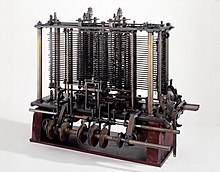Completed models
The Science Museum has constructed two Difference Engines according to Babbage's plans for the Difference Engine No 2. One is owned by the museum. The other, owned by the technology multimillionaire Nathan Myhrvold, went on exhibition at the Computer History Museum[158] in Mountain View, California on 10 May 2008.[159] The two models that have been constructed are not replicas.
Analytical Engine
After the attempt at making the first difference engine fell through, Babbage worked to design a more complex machine called the Analytical Engine. He hired C. G. Jarvis, who had previously worked for Clement as a draughtsman.[160] The Analytical Engine marks the transition from mechanised arithmetic to fully-fledged general purpose computation. It is largely on it that Babbage's standing as computer pioneer rests.[161]
The major innovation was that the Analytical Engine was to be programmed using punched cards: the Engine was intended to use loops of Jacquard's punched cards to control a mechanical calculator, which could use as input the results of preceding computations.[162][163] The machine was also intended to employ several features subsequently used in modern computers, including sequential control, branching and looping. It would have been the first mechanical device to be, in principle, Turing-complete. The Engine was not a single physical machine, but rather a succession of designs that Babbage tinkered with until his death in 1871.[citation needed]
Ada Lovelace and Italian followers
Ada Lovelace, who corresponded with Babbage during his development of the Analytical Engine, is credited with developing an algorithm that would enable the Engine to calculate a sequence of Bernoulli numbers.[164] Despite documentary evidence in Lovelace's own handwriting,[164] some scholars dispute to what extent the ideas were Lovelace's own.[165][166][167] For this achievement, she is often described as the first computer programmer;[168][failed verification] though no programming language had yet been invented.[164][169]
Lovelace also translated and wrote literature supporting the project. Describing the engine's programming by punch cards, she wrote: "We may say most aptly that the Analytical Engine weaves algebraical patterns just as the Jacquard loom weaves flowers and leaves."[163]
Babbage visited Turin in 1840 at the invitation of Giovanni Plana, who had developed in 1831 an analog computing machine that served as a perpetual calendar. Here in 1840 in Turin, Babbage gave the only public explanation and lectures about the Analytical Engine.[170][171] In 1842 Charles Wheatstone approached Lovelace to translate a paper of Luigi Menabrea, who had taken notes of Babbage's Turin talks; and Babbage asked her to add something of her own. Fortunato Prandi who acted as interpreter in Turin was an Italian exile and follower of Giuseppe Mazzini.[172]
Swedish followers
Per Georg Scheutz wrote about the difference engine in 1830, and experimented in automated computation. After 1834 and Lardner's Edinburgh Review article he set up a project of his own, doubting whether Babbage's initial plan could be carried out. This he pushed through with his son, Edvard Scheutz.[173] Another Swedish engine was that of Martin Wiberg (1860).[174]
Legacy
In 2011, researchers in Britain proposed a multimillion-pound project, "Plan 28",[175] to construct Babbage's Analytical Engine. Since Babbage's plans were continually being refined and were never completed, they intended to engage the public in the project and crowd-source the analysis of what should be built.[176] It would have the equivalent of 675 bytes of memory, and run at a clock speed of about 7 Hz. They hoped to complete it by the 150th anniversary of Babbage's death, in 2021.[177]
Advances in MEMS and nanotechnology have led to recent high-tech experiments in mechanical computation. The benefits suggested include operation in high radiation or high temperature environments.[178] These modern versions of mechanical computation were highlighted in The Economist in its special "end of the millennium" black cover issue in an article entitled "Babbage's Last Laugh".[179]
Due to his association with the town Babbage was chosen in 2007 to appear on the 5 Totnes pound note.[180] An image of Babbage features in the British cultural icons section of the newly designed British passport in 2015.[181]
You received this message because you are subscribed to the Google Groups "1top-oldtattoo-2" group.
To unsubscribe from this group and stop receiving emails from it, send an email to 1top-oldtattoo-2+unsubscribe@googlegroups.com.
To view this discussion on the web visit https://groups.google.com/d/msgid/1top-oldtattoo-2/CALML-R2bxk%2BGqh%2B1A-sS0ehPxfx_x4G%3DYuWLHRy44BwtB%2BHB1Q%40mail.gmail.com.


No comments:
Post a Comment